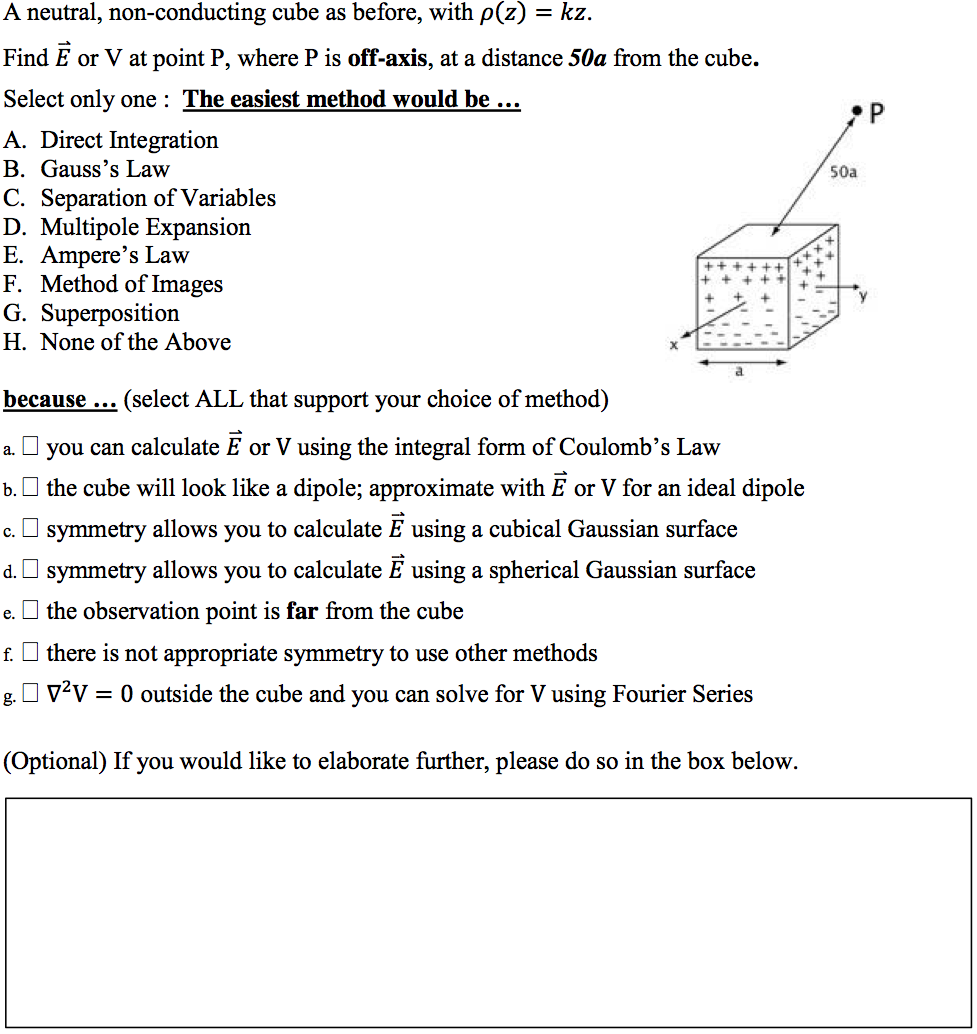Developed by Bethany Wilcox and Steven Pollock
| Purpose | To assess skills in first semester upper-level E&M, such as the ability to visualize a problem, correctly apply problem-solving methods, connect math to physics, and describe limiting behavior. |
|---|---|
| Format | Pre/post, Multiple-choice, Multiple-response |
| Duration | Pre: 20 min; Post: 50 min |
| Focus | Electricity / Magnetism Content knowledge (electrostatics, magnetostatics, choosing a problem-solving method) |
| Level | Upper-level |
Sample question from the CUE-CMR:
CUE-CMR Implementation and Troubleshooting Guide
Everything you need to know about implementing the CUE-CMR in your class.
Login or register to download the implementation guide.
The Colorado Science Education Initiative has developed a wide range of curricular materials for teaching junior-level electrostatics, of which the CUE-CMR is only one. Please visit the course website for other materials such as group activities, clicker questions, and homework.
more details
This is the highest level of research validation, corresponding to all seven of the validation categories below.
Research Validation Summary
Based on Research Into:
- Student thinking
Studied Using:
- Student interviews
- Expert review
- Appropriate statistical analysis
Research Conducted:
- At multiple institutions
- By multiple research groups
- Peer-reviewed publication
The questions on the CUE-CMR are adapted from the CUE-FR, which is the free-response version of the test. The multiple-choice responses on the CUE-CMR come from student solutions and the grading rubric for the free-response version of the test. The test questions underwent expert review and were refined through student interviews. CUE-CMR scores correlate strongly with standard exam scores (r=0.79). Appropriate statistical analyses of difficulty, discrimination and internal consistency were conducted. The CUE-CMR has been given to over 50 students at one institution. The results are published in two peer-reviewed publications.
References
- S. Chasteen, R. Pepper, S. Pollock, and K. Perkins, But Does It Last? Sustaining a Research-Based Curriculum in Upper-Division Electricity & Magnetism, presented at the Physics Education Research Conference 2011, Omaha, Nebraska, 2011.
- R. Pepper, S. Chasteen, S. Pollock, and K. Perkins, Our best juniors still struggle with Gauss’s Law: Characterizing their difficulties, presented at the Physics Education Research Conference 2010, Portland, Oregon, 2010.
- R. Pepper, S. Chasteen, S. Pollock, and K. Perkins, Observations on student difficulties with mathematics in upper-division electricity and magnetism, Phys. Rev. ST Phys. Educ. Res. 8 (1), 010111 (2012).
- S. Pollock, R. Pepper, S. Chasteen, and K. Perkins, Multiple roles of assessment in upper-division physics course reforms, presented at the Physics Education Research Conference 2011, Omaha, Nebraska, 2011.
- C. Wallace and S. Chasteen, Upper-division students' difficulties with Ampère's law, Phys. Rev. ST Phys. Educ. Res. 6 (2), 020115 (2010).
- N. Weliweriya, E. Sayre, and D. Zollman, The Effectiveness of “Pencasts” in Physics Courses, Phys. Teach. 56 (3), 161 (2018).
- B. Wilcox, M. Caballero, C. Baily, H. Sadaghiani, S. Chasteen, Q. Ryan, and S. Pollock, Development and uses of upper-division conceptual assessments, Phys. Rev. ST Phys. Educ. Res. 11 (2), 020115 (2015).
- B. Wilcox and S. Pollock, Upper-division student difficulties with the Dirac delta function, Phys. Rev. ST Phys. Educ. Res. 11 (1), 010108 (2015).
- B. Wilcox and S. Pollock, Multiple-choice Assessment for Upper-division Electricity and Magnetism, presented at the Physics Education Research Conference 2013, Portland, OR, 2013.
- B. Wilcox and S. Pollock, Coupled multiple-response versus free-response conceptual assessment: An example from upper-division physics, Phys. Rev. ST Phys. Educ. Res. 10 (2), 020124 (2014).
- B. Wilcox and S. Pollock, Validation and analysis of the coupled multiple response Colorado upper-division electrostatics diagnostic, Phys. Rev. ST Phys. Educ. Res. 11 (2), 020130 (2015).
- J. Zwolak, M. Kustusch, and C. Manogue, Re-thinking the Rubric for Grading the CUE: The Superposition Principle, presented at the Physics Education Research Conference 2013, Portland, OR, 2013.
- J. Zwolak and C. Manogue, Assessing student reasoning in upper-division electricity and magnetism at Oregon State University, Phys. Rev. ST Phys. Educ. Res. 11 (2), 020125 (2015).
We don't have any translations of this assessment yet.
If you know of a translation that we don't have yet, or if you would like to translate this assessment, please contact us!

Login or register to download an excel scoring and analysis tool for this assessment.
| Typical Results |
|---|
Typical results on the CUE-CMR from (Wilcox and Pollock, 2014):
|
The latest version of the CUE-CMR, released in 2013, is version 9. The CUE-CMR is intended to replace the CUE-FR, a free response version of the same assessment. Version 9 of the CUE-CMR is comparable to version 22 of the CUE-FR.
Variation
|
|
Colorado Upper Division Electrostatics Diagnostic - Free ResponseContent knowledge Electricity / Magnetism (electrostatics, magnetostatics, choosing a problem-solving method)Upper-level Pre/post, Short answer |



